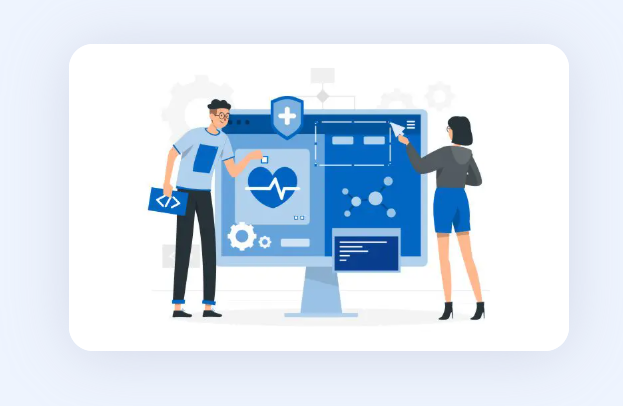Top Features Every Healthcare Website Should Have for Better Patient Engagement

In today’s digital age, a healthcare website is often the first point of contact between a medical provider and potential patients. For healthcare organizations, creating a website that not only informs but actively engages patients is essential for building trust, improving patient outcomes, and growing their practice. Successful healthcare web development involves more than just attractive design—it requires careful attention to features that enhance usability, accessibility, security, and communication.
This article explores the top features every healthcare website should have to maximize patient engagement and deliver a seamless, patient-centered digital experience. We’ll also integrate key concepts around healthcare website development and best practices in medical web development to help healthcare providers understand what it takes to build an effective online presence.
Why Patient Engagement Matters in Healthcare Web Development
Patient engagement refers to the actions patients take to participate actively in their own health and healthcare. Engaged patients tend to have better health outcomes, higher satisfaction rates, and improved adherence to treatment plans.
From a healthcare website perspective, engagement means designing digital platforms that:
-
Provide easy access to relevant health information
-
Encourage two-way communication
-
Facilitate convenient access to healthcare services
-
Support patient education and empowerment
Given the critical role of a website in the patient journey, healthcare organizations must prioritize key features during medical website development that foster engagement.
1. User-Friendly and Intuitive Design
A foundational feature of any healthcare website is a clean, intuitive user interface that patients of all ages and tech skill levels can navigate with ease. Complex or cluttered websites discourage patients from exploring content and can increase bounce rates.
Key design considerations include:
-
Simple, logical navigation menus
-
Clear calls-to-action (CTAs) such as “Book an Appointment” or “Contact Us”
-
Responsive design for mobile and tablet devices
-
Readable fonts and an accessible color palette
User-centered design principles in healthcare web development improve usability and help patients find the information or services they need quickly and easily.
2. Secure Patient Portal Integration
Secure patient portals are indispensable for enhancing engagement by providing patients with direct access to their health records, test results, appointment schedules, and billing information.
Features of an effective patient portal include:
-
HIPAA-compliant security measures
-
Ability to message healthcare providers securely
-
Online appointment scheduling and prescription refill requests
-
Access to personalized health education materials
Integrating a patient portal within the healthcare website streamlines communication and empowers patients to take control of their healthcare management remotely.
3. Online Appointment Booking and Telehealth Services
Convenience is paramount for today’s healthcare consumers. Offering online appointment scheduling directly on the website removes barriers, reduces administrative workload, and enhances patient satisfaction.
Moreover, telehealth capabilities have surged in importance, especially post-pandemic. Incorporating virtual visit options through your website can significantly boost patient engagement by providing accessible care options.
Essential functionalities include:
-
Real-time availability and booking system
-
Automated appointment reminders via email or SMS
-
Clear instructions for telehealth visits (technical requirements, privacy info)
-
Integration with calendar apps
This functionality highlights the importance of sophisticated medical website development tailored to evolving patient needs.
4. Comprehensive and Up-to-Date Health Information
Educational content is a powerful tool for patient engagement. A website should provide reliable, easy-to-understand health information, including:
-
Disease overviews and symptoms
-
Preventive care tips
-
Treatment options and FAQs
-
Blog posts or news updates on health topics
Content must be reviewed regularly by medical professionals to ensure accuracy and trustworthiness. This ongoing effort to deliver quality information positions the healthcare website as a valuable resource, encouraging repeat visits and patient loyalty.
5. Accessibility Compliance
A healthcare website must be accessible to all users, including those with disabilities, to ensure equitable access to information and services.
Adhering to standards such as the Web Content Accessibility Guidelines (WCAG) includes:
-
Providing alternative text for images
-
Ensuring keyboard navigation compatibility
-
Using sufficient color contrast for readability
-
Supporting screen readers
Accessibility is not just a legal obligation but a key aspect of patient-centered medical web development that promotes inclusivity.
6. Clear Contact Information and Location Details
Patients seeking healthcare services often prioritize ease of contact and location information. Your website should have:
-
Prominently displayed phone numbers and email addresses
-
Interactive maps and directions to facilities
-
Information on office hours and emergency contacts
-
Links to social media profiles
This transparency reassures patients and facilitates straightforward communication channels.
7. Online Bill Payment and Insurance Information
Financial transparency and convenience are critical components of patient engagement. A website should provide:
-
Secure online payment portals for bills and copays
-
Information about accepted insurance plans and coverage
-
Clear policies on billing and insurance claims
Simplifying these processes digitally reduces patient stress and administrative delays, contributing to a smoother healthcare experience.
8. Patient Testimonials and Reviews
Social proof plays a major role in influencing patient decisions. Featuring genuine patient testimonials and reviews on your healthcare website can build trust and credibility.
When incorporating reviews:
-
Ensure authenticity and privacy compliance
-
Showcase diverse patient experiences
-
Highlight positive outcomes and compassionate care
Well-placed testimonials can humanize the healthcare provider and foster emotional connection with prospective patients.
9. Multilingual Support
In increasingly diverse communities, offering multilingual website options can significantly improve engagement by breaking down language barriers.
Providing key pages and navigation in multiple languages ensures:
-
Better comprehension of health information
-
Enhanced comfort and trust
-
Broader patient reach
This feature is especially vital in areas with large populations of non-native English speakers.
10. Integration with Social Media and Patient Communities
Modern healthcare websites should leverage social media to extend patient engagement beyond the site itself.
Including social media feeds, share buttons, and links to online patient communities fosters:
-
Real-time updates and health campaigns
-
Peer support and shared experiences
-
Greater visibility and patient interaction
This integration helps create a continuous engagement ecosystem supporting health promotion.
11. Blog or News Section with Regular Updates
A blog section serves multiple purposes:
-
Provides a platform for expert articles and health news
-
Improves search engine optimization (SEO) through fresh content
-
Encourages patients to return to the site for updates
Regularly updated content demonstrates a commitment to patient education and ongoing communication.
12. Robust Search Functionality
Large healthcare websites often contain a vast amount of information. A powerful, easy-to-use search feature helps patients quickly locate relevant pages, services, or articles.
Advanced search capabilities include:
-
Predictive text suggestions
-
Filters by categories (symptoms, services, providers)
-
Results ranking by relevance
This improves the overall user experience and reduces frustration.
13. Clear Privacy Policy and Terms of Use
Given the sensitive nature of health data, displaying clear and comprehensive privacy policies and terms of use is crucial for transparency and compliance.
Patients must be informed about:
-
How their data is collected, stored, and used
-
Their rights regarding personal information
-
Security practices in place
Transparent policies build trust, which is foundational to engagement.
14. Analytics and Feedback Mechanisms
Finally, to continuously improve patient engagement, healthcare websites should implement analytics tools to monitor user behavior and feedback forms or surveys to gather patient opinions.
Insights gained can guide:
-
Content updates
-
Feature enhancements
-
User interface improvements
An iterative approach ensures the website evolves in line with patient needs and expectations.
Conclusion
Effective healthcare web development is a critical investment that directly impacts patient engagement, satisfaction, and outcomes. Incorporating these top features during medical website development ensures your digital platform serves as a trustworthy, convenient, and accessible resource that supports patients throughout their healthcare journey.
From user-friendly design and secure patient portals to educational content and telehealth integration, every element must be carefully crafted with the patient in mind. By prioritizing these features, healthcare organizations can foster deeper connections, streamline care delivery, and ultimately improve the health and well-being of their communities.
- Industry
- Art
- Causes
- Crafts
- Dance
- Drinks
- Film
- Fitness
- Food
- Games
- Gardening
- Health
- Home
- Literature
- Music
- Networking
- Other
- Party
- Religion
- Shopping
- Sports
- Theater
- Wellness
- News


